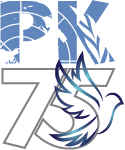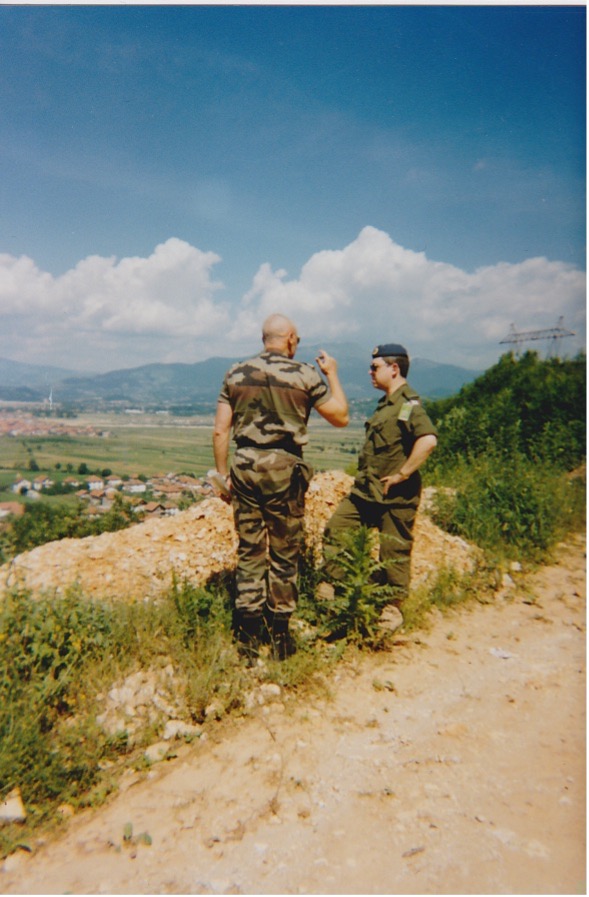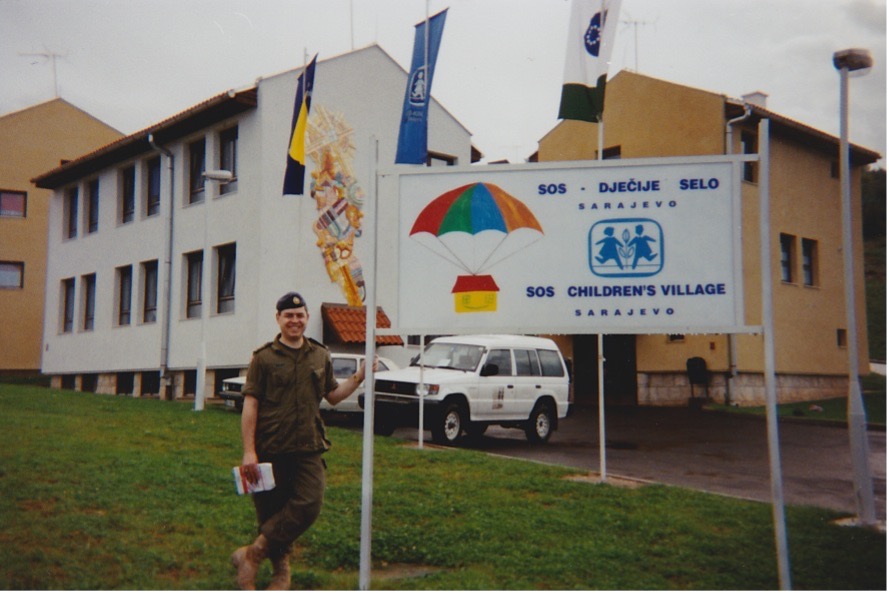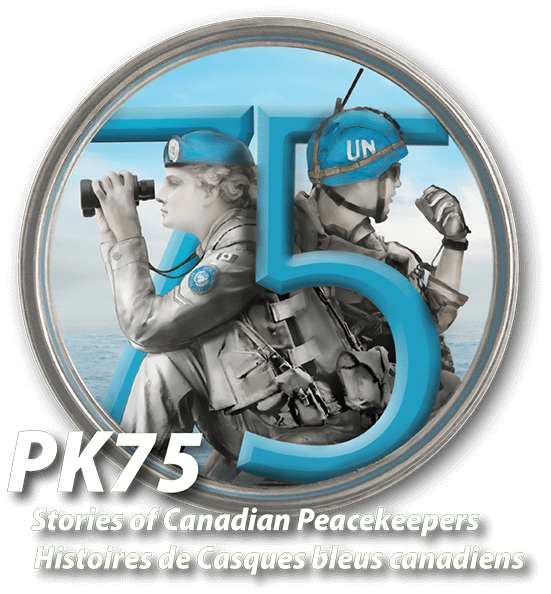

In June 1998, I departed AIRCENT Headquarters at Ramstein Air Base in Germany for a four-month deployment with the NATO Stabilisation Force (SFOR) Headquarters (HQ) in Sarajevo, Bosnia-Hercegovina. At the end of September, I returned to my normal duties in Ramstein. In my 30 years of service with the Canadian Forces, this was my only peacekeeping mission.
The deployment to Sarajevo started with a trip to the Peace Support Training Centre in Kingston ON for pre-deployment training. In May 1998, the damage from the ice storm that ravaged sections of the St. Lawrence Valley from Kingston to Québec’s Eastern Townships in January was still evident. Refreshed in basic weapons handling and emergency first aid, educated about the culture of the Balkans, trained in the dangers of mines, unexploded ordnance and improvised explosive devices, and admonished not to wander off the beaten path, I returned to Ramstein to complete my preparations for deployment.
When I departed Ramstein on 1 June, our first stop was Vicenza, Italy, where we were briefed about the situation in the Balkans and the issues confronting SFOR in its mission to deter violence and provide the safe, secure environment needed for the consolidation of peace in Bosnia-Herzegovina. My next stop, after a couple of days in Sarajevo, was Camp Black Bear in Velika Kladusa (known as ‘VK’), a town in north-western
Bosnia-Herzegovina.
The Command Element of the 1200-strong Canadian Contingent in SFOR was located at Camp Black Bear and all Canadian officers deployed to Bosnia had to check-in with the Commander of the Canadian Contingent. In 1998, this was Walter Natynczyk, a future Chief of the Defence Staff. The round trip between Sarajevo and VK was an eye-opening, all-day introduction to Bosnia-Hercegovina.
During the four months that I was in Sarajevo, I served as the Executive Officer (XO) to the CJ2, the senior Intelligence Officer in SFOR. SFOR HQ was a multinational organisation and the CJ2 Branch comprised personnel from every country in Western Europe.
Towards the end of June, Patricia, a French Sergeant, took me to visit a new, not-yet-occupied orphanage in Sarajevo. It was obvious that this haven of security for Bosnia’s youngest victims suffered from a serious deficiency in toys. A week later, I returned to Ramstein on a 96-hour furlough, where I spoke to our children, Theodore (4) and Victoria (almost 2), about the orphans in Bosnia. When I returned to Sarajevo, my luggage had swelled by two duffle bags full of their toys for the orphanage. I could not have been prouder of my kids for their compassion and generosity.
On another occasion, Jean, a French Colonel, invited me to accompany him on a trip to the Serbian refugee camp at Pale, the ski resort that had hosted the Winter Olympics in 1984. The Pale resort and its many hotels housed hundreds of displaced Serbian families. After distributing donated food, clothes and toiletries, Jean and I visited a Serbian family. Despite their limited means, they insisted on serving us tea and cookies. It was another eye-opening experience.
My last memory involved a tour of the 1995 battlefield that prompted NATO intervention in the siege of Sarajevo in 1995. Andre was a French Lieutenant Colonel who had served as an observer during those troubled days in 1995. He took me on a tour of several vantage points on the hills south of the Sarajevo airport, to familiarise me with the battlefield that had dominated international headlines for 1,425 days during the Siege of Sarajevo. We then visited a Bosnian family who lived near the airport who had an access point on their property to one of the tunnels that ran beneath the airport. Those tunnels provided a vital lifeline for the Bosnians who were besieged in Sarajevo. Again, without regard for their circumstances, the family insisted that we join them for coffee and sweets.
My first and only peacekeeping mission was a career-affirming experience that confirmed for me, in a way that no amount of work in Canada supporting operations at home and abroad operations ever could, the importance of the work we performed while wearing the uniform of the Canadian Forces.
Biography
Robert Glyn Nash was born in Stratford ON in 1960 and grew up in the nearby town of St Marys. He joined the Canadian Forces in 1979. In 1983, Second Lieutenant Nash graduated with a BSc in Honours Mathematics and Physics at the Royal Military College (RMC). After training as an Aerospace Engineering Officer, Lieutenant Nash was posted to 403 (Helicopter) Operational Training Squadron at Canadian Forces Base (CFB) Gagetown, NB. In 1985, he participated in Exercise RENDEZVOUS 85.
Robert was posted to National Defence Headquarters in Ottawa 1986, where he managed engineering support for the air-to-air missiles on the CF-18 HORNET. During this posting, his duties involved his first official trip to Europe and trips to Washington DC, Norfolk VA, and Tampa, FL.
In 1988, Captain Nash retrained as an Intelligence Officer and was posted to 4 (Fighter) Wing at CFB Baden in Germany. Following the invasion of Kuwait by Iraq in 1990, Robert contributed to the deployment of CF-18s during Operation FRICTION. Robert deployed for four weeks to Qatar with Canadian Air Task Group Middle East in February 1991. During his time in Baden, Robert served as a volunteer disc jockey for the Canadian Forces Network radio station and as a host for the Canadian Club of Southern Germany.
Robert was posted to Headquarters Fighter Group/Canadian NORAD Region in North Bay, ON in 1992. He served as a Cadet Liaison Officer during this posting. Promoted Major in 1994, Robert was next posted to the Canadian Forces School of Intelligence and Security (CFSIS) at CFB Borden, ON. At CFSIS, Robert led a major rewrite of training for Intelligence Operators and Officers and chaired a successful United Way campaign.
In 1997, Major Nash was posted to NATO’s AIRCENT Headquarters at Ramstein Air Base in Germany. In Ramstein, Robert served as an analyst and exercise planner, and as a Team Leader in the NATO Tactical Evaluation (Tac Eval) program. In 1998, Robert deployed to Sarajevo, Bosnia-Hercegovina, where he served with the Headquarters of the NATO-led Stabilization Force (SFOR). In 1999, Robert participated in a Partnership for Peace (PfP) exercise in Slovakia.
Major Nash was posted to Headquarters, 1 Canadian Air Division/Canadian NORAD Region Headquarters in Winnipeg MB in 2000. Robert was in the Operations Centre on the morning of 11 September 2001 and watched United Airlines Flight 175 crash into the South Tower of the World Trade Center on the big screen. Suddenly, years of training became reality for NORAD. Robert received a Commander’s Commendation for his contribution during Operation GRIZZLY, the security operation to secure the G8 conference in Kananaskis AB in 2002. In Winnipeg, Robert completed a Master of Arts degree in War Studies through RMC that he started while in Borden.
In 2003, the Nash family moved to Ottawa when Robert was posted to the Chief of the Air Staff organisation. Responsibilities for Canada’s contribution to allied interoperability programs provided Robert opportunities for travel to Australia, San Diego CA, the United Kingdom, and Belgium.
Major Nash’s last posting with the Canadian Forces was to London UK, where he served as the Deputy Canadian Forces Intelligence Liaison Officer. This was a representational position where Robert supported the travel of Canadians to the UK and of Brits to Canada, and the exchange of information between Canada and the United Kingdom. Robert reached the pinnacle of his career when he was promoted Lieutenant Colonel in 2008. In 2009, Robert resigned from the Canadian Forces.
In September 2009, the Nash family emigrated to New Zealand, where Squadron Leader Nash served for six years with the Royal New Zealand Air Force (RNZAF) in Wellington. Robert was first assigned to the Headquarters, Joint Forces New Zealand, where he supported operations in Afghanistan, East Africa, and Oceania, and participated in a Five Powers Defence Arrangements (FPDA) exercise in Singapore. Following Command and Staff College, where Robert was named the top student and earned a master’s degree in international security, Robert served as the National Program Manager for the Air and Space Interoperability Council (ASIC) at Headquarters RNZAF. Robert ended his military career as the NZDF Teaching Fellow at Massey University.
Robert married Alice van Saarloos in 1985. They had four children during four consecutive postings: Caitlin (1992), Theodore (1993), Victoria (1996) and Jennifer (1999). In December 2015, they moved to Winnipeg where Robert works as a military contractor, volunteers with the Canadian International Council and the Canadian Military Intelligence Association, and, fancying himself an amateur historian, pursues his many interests in Canadian military history.

Sarajevo airport tour with André.

SOS Childrens’ Village.


